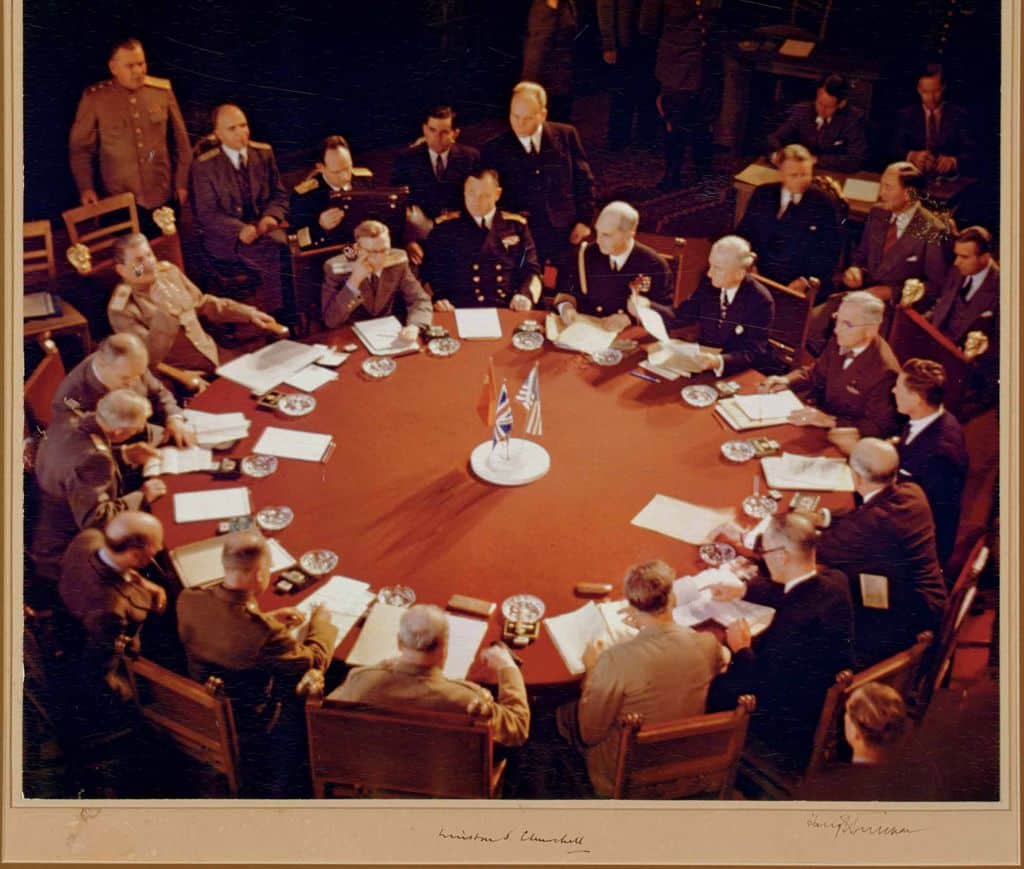
The issue was the new shape of postwar Europe. There was no longer a question regarding German defeat. In the east, Soviet forces were 65 km (40 mi) from Berlin, having already pushed back the Germans from Poland, Romania, and Bulgaria. Livadia Palace, Crimea, RSFSRĭuring the Yalta Conference, the Western Allies had liberated all of France and Belgium and were fighting on the western border of Germany. Marshall, Ambassador Averell Harriman, Admiral William Leahy, and President F. Yalta American Delegation in Livadia Palace from left to right: Secretary of State Edward Stettinius, Maj. It was also preceded by a conference in Moscow in October 1944, not attended by Roosevelt, in which Churchill and Stalin had spoken of European Western and Soviet spheres of influence. It was preceded by the Tehran Conference in November 1943 and was followed by the Potsdam Conference in July 1945.

Yalta was the second of three major wartime conferences among the Big Three. Intended mainly to discuss the re-establishment of the nations of war-torn Europe, within a few years, with the Cold War dividing the continent, the conference became a subject of intense controversy.

The aim of the conference was to shape a postwar peace that represented not only a collective security order but also a plan to give self-determination to the liberated peoples of Europe. The conference was held near Yalta in Crimea, Soviet Union, within the Livadia, Yusupov, and Vorontsov palaces. Roosevelt, Prime Minister Winston Churchill, and General Secretary Joseph Stalin, respectively. The three states were represented by President Franklin D. The Yalta Conference (codenamed Argonaut), also known as the Crimea Conference, held 4–11 February 1945, was the World War II meeting of the heads of government of the United States, the United Kingdom, and the Soviet Union to discuss the postwar reorganization of Germany and Europe. Kuter, General Aleksei Antonov, Vice Admiral Stepan Kucherov, and Admiral of the Fleet Nikolay Kuznetsov. Leahy, General of the Army George Marshall, Major General Laurence S. Behind them stand, from the left, Field Marshal Sir Alan Brooke, Fleet Admiral Ernest King, Fleet Admiral William D. The deeply conflicting aims of the Western democracies on the one hand and the Soviet Union on the other meant that Potsdam was to be the last Allied summit conference.The " Big Three" at the Yalta Conference, Winston Churchill, Franklin D. In eastern Europe, the governments of Romania, Hungary, and Bulgaria were already controlled by communists, and Stalin refused to let the Allies interfere in the region. Each country was most concerned with its own self-interest, and Churchill in particular was suspicious of Stalin’s motives and unyielding position. The goodwill that had largely characterized earlier wartime conferences was missing at Potsdam. After Japan rejected this ultimatum, the United States dropped atomic bombs on Hiroshima and Nagasaki. On July 26, 1945, an ultimatum was issued from the conference demanding Japan’s unconditional surrender and threatening heavier air attacks otherwise. While in Potsdam, President Truman told Stalin about the “new weapon” (the atomic bomb) that the United States intended to use against Japan. This required moving millions of Germans in those areas to Germany. Poland’s boundary was set at the Oder and Neisse rivers in the west, and the country received part of Germany’s former East Prussia province.
.jpg)

Each Allied power was to take reparations from its own occupation zones. Berlin, Vienna, and Austria were also each divided into four occupation zones. The Potsdam Conference’s Declaration on Germany stated: “It is the intention of the Allies that the German people be given the opportunity to prepare for the eventual reconstruction of their life on a democratic and peaceful basis.” The four occupation zones of Germany conceived at the Yalta Conference (February 1945) were set up-each to be administered by the commander-in-chief of the Soviet, British, U.S., or French army of occupation. The leaders also discussed the occupation of Austria, the borders of Poland, the determination of reparations, and the Soviet Union’s role in eastern Europe. The main concerns at Potsdam included the administration of defeated Germany and the continuing military campaign against Japan. That task was left to a Council of Foreign Ministers. The leaders discussed peace settlements for Europe but did not attempt to write peace treaties.


 0 kommentar(er)
0 kommentar(er)
